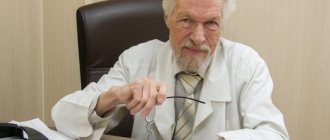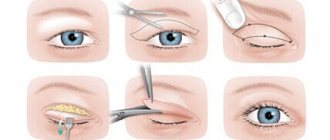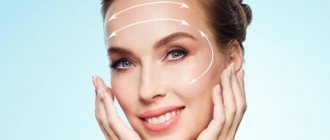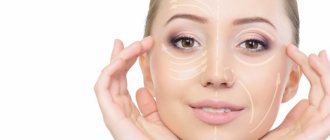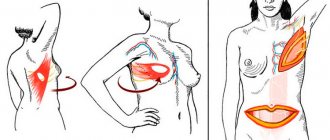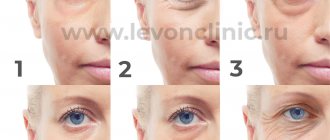Every woman wants to have a beautiful, fresh, young face for as long as possible. And facelifts with mesothreads are becoming increasingly popular.
Mesothreads are synthetic fibers made from polydiaxone, which is coated on top with a moisturizing composition based on polyglycolic acid. They are injected under the skin and create a framework of facial contours. Over time, the threads dissolve, but the frame remains, which makes the effect of the procedure long-lasting.
Sventitsky E. V.
You may be interested in:Nose tip reduction: description of procedures, results, photos and reviews
More than anyone else, Evgeniy Vasilyevich Sventitsky deserves to open the list of the best plastic surgeons in Tver. Specialist of the highest category, Honored Doctor of the Russian Federation, winner of the medals “Excellence in Health Care” and “For Valorous Work”, founder and head of two of the most outstanding aesthetic surgery clinics in Tver, one of which is named after him - all this is Evgeniy Vasilyevich, 55 years of his life dedicated to plastic and cosmetological medical art. It is worth noting that this doctor has repeatedly performed important plastic surgeries in the Kremlin clinic.
Evgeniy Vasilyevich is the head and receptionist at the Tver plastic surgery clinics “Cosmetology Clinic” on Trekhsvyatskaya Street, 14 and “Svetnitsky Clinic” on Spartak Street, 42 B.
Types of mesothreads
- Smooth or monofilament. They represent the finest fibers for universal use. Monofilaments can be used to tighten the contours of the cheeks, lips, face, nasolabial folds, and chin.
- Spiral. They represent small tightly coiled “springs”. When installed, they straighten and effectively support the desired area. They are mainly used to correct areas of the chin, eyebrows, and décolleté.
- Wicker. The pattern of such mesothreads represents a braid woven from several fibers. They have the best performance in keeping the skin elastic and are used to correct problem areas of the abdomen, buttocks, and sides.
- Needle-shaped. They have special notches and spikes and are considered the most effective because they quickly model the oval of the face. The effect of such lifting lasts for a long time. Local anesthesia is required during installation as the procedure is painful.
Sergienko E. N.
Of the relatively young specialists, the most outstanding, undoubtedly, is Elena Nikolaevna Sergienko, a plastic and maxillofacial surgeon of the highest category, Doctor of Medical Sciences, teacher at the Department of Aesthetic Medicine and Cosmetology at TSMU. It’s hard to imagine that such a qualified specialist has only 18 years of experience, but Elena Nikolaevna has a wealth of experience behind her.
You can seek help from Dr. Sergienko at the “Clinic of Restorative Medicine” at 22 Tatarsky Lane and at the Regional Clinic at 105 Petersburg Highway.
Indications and contraindications
Indications for installing mesothreads are as follows:
- wrinkles of varying severity, “crow’s feet” around the eyes;
- sagging skin of the face, neck, abdomen, buttocks;
- aptosis of gravitational nature of the cheeks, eyebrows, forehead.
The procedure has general and local contraindications. General circumstances include the following:
- autoimmune and any chronic diseases in the acute stage:
- pregnancy and the period of feeding the baby;
- hematological diseases;
- oncology;
- age under 18 years;
- diabetes mellitus of both types.
Local contraindications include:
- the presence of age spots, moles in the treatment area;
- infectious processes on the skin in the inflammation stage;
- menstruation.
After the procedure, it is not recommended to take very hot baths or visit saunas and steam baths for 3 weeks. During this time, facial massage is prohibited. After the introduction of mesothreads, small bruises, swelling, and hematomas may remain in the selected area. They resolve within 2–3 days after the procedure.
Sedov Yu. A.
Another outstanding plastic surgeon in the city is Yuri Anatolyevich Sedov, a doctor of the highest professional level, Candidate of Medical Sciences, whose professional experience is 24 productive and successful years.
Where can I make an appointment with this specialist in Tver?
- Sventitsky Plastic Surgery Clinic on Spartak Street, 42 B.
- Clinic "Genetis" on Skvortsova-Stepanova street, 34.
- Pirogov Hospital on Spartak Street, 42 B.
Portenko Yu. G.
It is impossible to imagine plastic surgery in Tver without a specialist of the highest category, Yuri Gennadievich Portenko, winner of the “Best Surgeon 2017” award, a Ph.D. degree and 20 years of experience behind him. Yuri Gennadievich’s great advantage is his specialization not only in plastic, but also in traditional surgery, which allows him to do not only beautiful, but also reliable, safe and durable work.
Here is a list of places where surgeon Portenko waits for his clients:
- Clinic "Harmony" on Zhelyabova street, 75.
- Honey. on Volokolamsky Avenue, 20/1.
- Children's regional hospital on Stepan Razin embankment, 23.
SMAS-lifting (biothermal plastic)
This technique was created for those who are not ready to decide on plastic surgery for a facelift. This is a technique for those who are ready to spend one hour and look great without surgery, without anesthesia and without scars.
Surgical SMAS-lifting has been replaced by a new method of rejuvenation - non-surgical ultrasound SMAS-lifting.
This is the latest technique for tightening the soft tissues of the face using HIFU (High Intensity Focused Ultrasound) high-intensity focused ultrasound. With the advent of this technology, it has become possible to influence the muscles of the face, neck, and décolleté. And provide lifting at the SMAS level, previously available only during a surgical facelift.
The term SMAS is an abbreviation (musculo-aponeurotic system). It stands for superficial muscular aponeurotic system. It is a component of the facial muscles.
With age, changes occur not only in the skin, but also in the smas layer, which leads to its loss of its functions as a facial frame. Under the influence of gravity, this layer stretches and moves downward. Age-related changes appear: blurred contours of the oval of the face, the appearance of a double chin, drooping eyelids and eyebrows. These gravitational changes cannot be reversed by acting only at the skin level.
Ultrasonic SMAS - lifting is the first technique, the effect of which is directed not on the skin, but on the underlying layer of SMAS. The penetration depth of the ultrasonic pulse is up to 5 mm. And therefore, hardware lifting can now serve as an alternative to surgical facelift.
The principle of the technique’s influence
The HIFU technology is based on the impact of a focused ultrasound wave on the smas muscle layer. Under the influence of intense focused ultrasound, selective spot heating of the smas occurs, which leads to its contraction and compression, providing immediate and prolonged tightening of the facial frame.
In addition to the immediate effect, this technique provides an increasing effect over several months, since the effect of ultrasound leads to the activation of the synthesis of new collagen and elastin fibers.
Result
The visible effect appears immediately, and the final result appears within another 4-6 months.
Important
The ultrasound wave passes overlying structures (skin, subcutaneous fat) without damaging them. That is, there are NO traces left on the skin after the procedure.
Advantages of the technique
- This is a hardware technique. Without anesthesia, without a scalpel, without stitches and without a long recovery period.
- lifting effect comparable only to surgical lifting.
- minimum time for the procedure: from 30 minutes to 60 minutes.
- immediate effect immediately after the procedure
- clinically proven cumulative effect for 4 ÷ 6 months
- sustainable long-term results for 2-3 years
- without a long course of procedures (most often 1 session is needed)
- short rehabilitation period (from several hours to a day)
- year-round availability of the procedure
- non-invasiveness of the procedure (the skin is not damaged) in contrast to laser rejuvenation, thread lifting and softfilling.
- no traces of impact remain
- minimum restrictions after a SMAS lifting session
How many sessions are needed?
Ultrasonic SMAS lifting is usually performed once. In rare cases, there is a need for a repeat procedure.
Indications for SMAS - lifting
- prevention of age-related changes in the skin of the face, neck, décolleté
- sagging skin, decreased density of skin and subcutaneous structures
- deformation and loss of clarity of the oval of the face
- drooping and deepening of nasolabial folds
- drooping cheekbones, cheeks and lip corners
- drooping eyebrows and ptosis of the upper eyelid
Contraindications
- pregnancy, lactation
- exacerbation of chronic skin diseases
- presence of a pacemaker
- mental disorders, epilepsy
- tendency to form keloid scars
- oncological diseases
Recommendations after the procedure
- refusal to visit the bathhouse, sauna, solarium
- Avoiding vigorous physical activity that causes profuse sweating
- refusal of peelings and scrubs in the area of the procedure
- use of sunscreen
Kogan M. R.
Another candidate of surgical sciences and teacher at TSMU on this list, as well as a doctor of the highest professional level with more than 20 years of experience, is Mikhail Rudolfovich Kogan, specializing in plastic, maxillofacial and dental surgery.
In Tver, doctor Kogan works at Lukina Street, 30. In addition, you can make an appointment with him at the Higher Volchok “Komir” clinic on Krasnykh Pechatnikov Street, 36.
Zvereva Yu. N.
And the wonderful specialist Yulia Nikolaevna Zvereva has been practicing plastic surgery in Tver for 15 years. Her areas of specialization also include maxillofacial surgery and medical (clinical) cosmetology.
Surgeon Zverev is waiting for his potential clients at the Triomed Center for Aesthetic Medicine on Krasnoflotskaya Embankment, 17 and at the Russian Railways Hospital on Arseniya Stepanova Street, 2 A.
Breast lift
Breast lift, or mastopexy, is a plastic surgery operation aimed at aesthetic correction of the shape and position of the mammary glands.
Sooner or later, almost every woman is faced with the phenomenon of mastoptosis - prolapse of the mammary gland. This physiological process can affect various tissues, and the degree of prolapse varies. If we are talking about a serious stage, then the breast changes its appearance quite significantly - the upper pole of the gland becomes flattened, the nipple-areolar complex drops significantly, the entire breast as a whole becomes flattened; the overhang of the bust over the submammary (inframammary) fold increases.
Practice shows that the mammary gland is able to effectively resist the downward effect of gravity if its protrusion in front (anterior projection) is 30% or less of the diameter of the base. As a rule, small breasts demonstrate much greater stability than large busts (however, small breasts are by no means a panacea for mastoptosis).
The main task of mastopexy is a complex correction designed to solve two main problems:
- raising the area of the nipple-areolar complex and the entire mammary gland relative to the current position;
- giving the breast the most aesthetically attractive shape, best suited to the patient’s specific physique.
In general, a breast lift is the price of obtaining an elastic, shaped, aesthetically pleasing bust.
It is the need for complex correction that is the reason for using not only the relatively minimally invasive periareolar surgical intervention, but also the method of vertical (T-shaped) breast lift. It is associated with the formation of more scars, but avoids further flattening of the breast.
Breast lift surgery is often combined with other corrective plastic surgery techniques, primarily breast augmentation. Such an integrated approach is in demand in situations where the volume of glandular tissue in the patient is minimal. A complex operation makes it possible to obtain a much more spectacular shape and clearly defined bust contours. Another combined option is mastopexy in combination with breast reduction (if the size and weight of the mammary glands are excessively large, which provokes severe sagging and ptosis).
It is necessary to take into account that with a simple breast augmentation operation, the existing prolapse will not disappear; Moreover, the increased mass of the mammary gland will contribute to the further development of mastoptosis.
The following types of mastoptosis are distinguished (according to the degree of progression and anatomical features):
- 1st degree ptosis - the nipple of the mammary gland is located at the same level with the inframammary (submammary) fold;
- 2nd degree ptosis - the nipple is located between the inframammary fold and the lower contour of the mammary gland;
- ptosis of the 3rd degree - the nipple is located on the lower contour of the mammary gland, with the nipple directed downward and not forward;
- pseudoptosis - with a normal position of the nipple (above the inframammary fold), drooping of the lower part of the mammary gland is observed, as well as general hypoplasia;
- glandular ptosis - with a normal position of the nipple (above the inframammary fold) and normal breast volume, sagging of the lower part of the gland is observed; This phenomenon is quite often a consequence of reduction mammoplasty once performed.
Doguzova N.V.
Another young but promising representative of plastic medicine in the city of Tver is Natalya Valeryevna Doguzova, who has currently worked in medicine for a little over seven years.
For advice and further assistance, you can contact specialist Doguzova at the “Cosmetology Clinic” clinic on Trekhsvyatskaya Street, 14 and at the Russian Railways Hospital on Arsenia Stepanova Street, 2 A.
Breast augmentation surgery (prosthetics), known in terminology as augmentation mammoplasty, is used: - to increase the volume and improve the shape of the breast while maintaining function (the possibility of breastfeeding); - to restore breast volume after pregnancy or after sudden weight loss; - to eliminate differences in breast size; - as a restorative procedure after surgery to remove a tumor in the mammary gland.The effect is achieved through the placement of a special prosthetic implant. The goal of the surgery is to give the breasts an improved shape and size that is proportional to the figure. The effect is achieved by placing under the breast tissue or even deeper (in the pectoral muscle) a special prosthetic implant having a silicone or polyurethane shell filled with a cohesive gel. Indications for surgery Breast augmentation is usually performed for both aesthetic and reconstructive purposes (for example, after breast surgery). Planning your surgery During your consultation with your surgeon, it is important to discuss your wishes and listen to their opinion. Every patient, like every doctor, has a different idea of the desired breast size and shape. The doctor will examine your breasts and take the necessary measurements and explain the specifics of the operation in relation to your age, skin condition, breast shape and size. If your breasts have a saggy appearance, your surgeon may also recommend performing a breast lift at the same time. The surgeon should describe the procedure in detail, explaining any possible limitations and uncertainties. Be sure to discuss all your questions with him. Preparation for surgery - the patient must be healthy (no colds or other diseases); — it is necessary to undergo an examination (blood tests, urine tests, sugar levels, ECG, oncologist’s report), as well as an examination by an anesthesiologist; — 10 days before surgery, you should not take medications containing aspirin, vitamin E, or lecithin; - if you smoke, you will have to abstain from smoking; - the night before you should take a bath, a light dinner is allowed; — you must bring a soft bra without a metal base; - no cosmetics, nail polish, etc. Performing the operation Breast augmentation surgery is usually performed under general anesthesia and lasts about 2 hours. There are several methods of performing the operation. The method of inserting the implant and its location will depend on your body anatomy and your surgeon's recommendations. The incision may be made in the lower crease of the breast, around the areola, or in the armpit. Through an incision, the surgeon separates your breast tissue and skin to create a “pocket” just behind the breast tissue or behind the chest wall muscle (pectoralis muscle). Some surgeons believe that placing the implant behind the pectoral muscle may reduce the possibility of capsular contracture. This placement interferes less with breast examinations (mammograms) than placement directly behind the breast tissue. However, placement behind the pectoral muscle may cause pain for several days after surgery.
Features of the operation - an inconspicuous scar about 5 cm long remains; — over time, natural sagging of the breast occurs; - absolute symmetry is impossible; — the operation does not affect the likelihood of developing breast cancer; — difficulties for medical examination usually do not arise;
Postoperative period Discharge from the hospital is carried out on the 3rd or 5th day after the operation, but you will be able to start work no earlier than a week later (depending on your well-being); during the first 3 weeks, and especially in the first five days after implantation of prostheses, hand movements should be limited; There may be a slight increase in temperature for several days; You must come for examinations once a week for a month; sutures are removed after 5-7 days; the final result appears after 2-3 months.
| Implant placement methods |
Possible side effects Temporary: - discomfort or pain when moving; - decreased sensitivity of some areas of the skin; - swelling of tissues and associated asymmetry of the mammary glands. Permanent: - postoperative scars form; - in some cases, the sensitivity of the nipples decreases or increases; Early postoperative complications (bleeding, infection, severe scarring) are rare. Scars after mammoplasty remain forever. They typically appear pinkish for six weeks, after which they become less noticeable, sometimes appearing as fine white lines. Fortunately, the scars are usually positioned so that you can wear low-cut clothing. The final result of the operation depends not only on the skill of the surgeon, but also on the individual characteristics of the patient and his compliance with all the instructions and recommendations of the doctor.
Examples of the results of operations performed:
Denis A. G.
A plastic surgeon of the highest category, the chief freelance maxillofacial surgeon of the Tver region, a professional dentist and periodontist - all this is Anna Grigorievna Denis, who has been giving her patients the desired beauty for more than 15 years.
An appointment with surgeon Anna Grigorievna Denis can be made at the medical center on Bragina Street, 18, and at the Children's Regional Hospital on Stepan Razin Embankment, 23.
Lordugin A.V.
The list of the best plastic surgery specialists in Tver is completed by Anna Valerievna Lordugin. For 9 years, this mistress of aesthetics and beauty has been working not only in the field of plastic surgery, but also in dermatology, venereology, cosmetology and maxillofacial surgery.
For an appointment with specialist Lordugin, you can come to the “Doctor Fomin Clinic” on Gorky Street, 107 A and to the “Afanasy” Clinic on Kominterna Street, 95.
I would like to think that this list of the most outstanding Tver specialists in the field of plastic surgery will help everyone who wants to finally decide on the choice of a doctor and not stop on the path to the desired perfection.
Source
